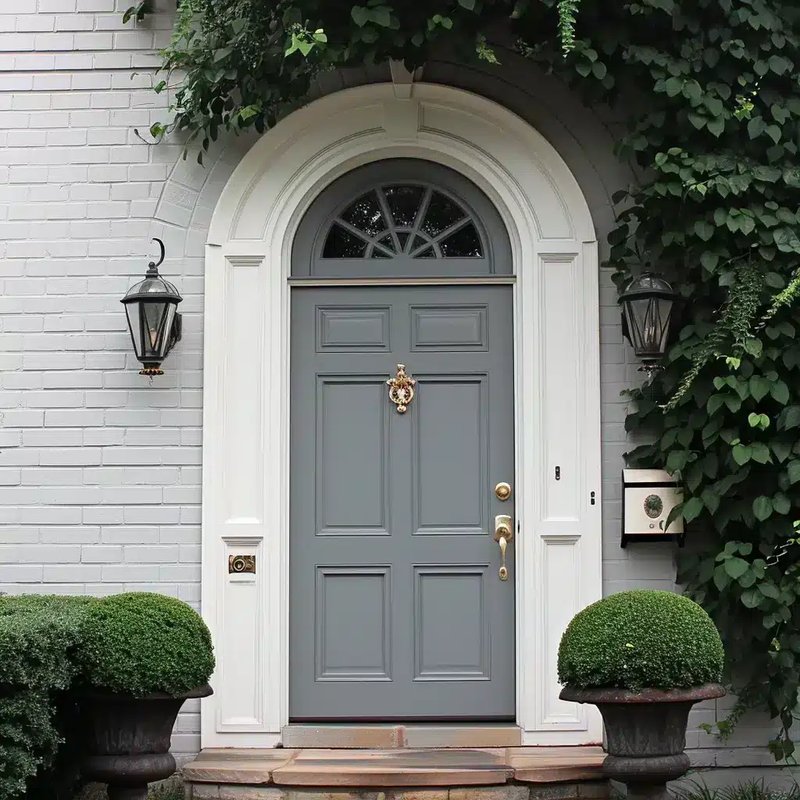
Most of us pay attention to the finish and color of our exterior doors—especially if it’s a specific style or a popular brand. But honestly, the hardware is what really takes a beating. Hinges, locks, and handles need care no matter which way your door faces. North-facing doors, in particular, deserve their own set of best practices since the threat isn’t heat or UV rays—it’s persistent moisture, chilly shade, and sometimes even more grime.
So, how should you maintain the hardware on a north-facing exterior door to keep it smooth, safe, and looking sharp? Let’s walk through some practical steps and smart habits that make a real difference—no matter which type or brand of door hardware you’re working with.
Why North-Facing Exterior Door Hardware Needs Special Attention
Here’s the thing: sunlight might age some things faster, but *shade isn’t always your friend* when it comes to door hardware. North-facing doors get less direct sunlight, which means they miss out on the natural drying power the sun provides. That might sound like a good thing—less sun damage!—but it creates a different set of problems.
Moisture lingers longer on shaded doors, especially after rain or in humid climates. Over time, this creates the perfect environment for rust, corrosion, and even subtle warping of metal parts. Plus, shady areas can attract mildew and grime that stick to every crevice, making your hardware look dull or feel gritty. All of this can add up to annoying issues, like keyholes that jam or handles that squeak.
If you own a popular brand like Schlage, Kwikset, or Yale, you might think higher quality protects you. To some extent, it definitely helps; good brands use better metals and coatings. But *no hardware is invincible*—especially when the enemy is slow, relentless moisture rather than just sun damage. That’s why it’s smart to give your north-facing door a little extra TLC, even if the finish still looks new.
Cleaning Hardware: The Right Way for North-Facing Doors
You might be wondering, “How often do I really need to clean the hardware on a shaded door?” The answer: more often than you think—especially if that door never gets a chance to dry out properly. Dirt, dust, and water stains have a sneaky way of sticking around, which can lead to corrosion or just make your nice hardware look worn out.
- Pick the right cleaner: Avoid harsh chemicals or abrasive pads. Instead, use mild dish soap with warm water and a soft microfiber cloth. This combo removes grime gently and won’t scratch coatings.
- Don’t forget crevices: Use a soft toothbrush to clean around screws, keyholes, and hinges where dirt collects. If you’re dealing with a sticky lock or keypad remote, compressed air can help clear debris without taking things apart.
- Dry thoroughly: This is essential for north-facing doors. Wipe hardware dry and let it air out before closing—otherwise, lingering moisture can undo all your work.
Let me explain: skipping regular cleaning on a shaded door can let tiny amounts of gunk build up inside locks and between moving parts. Over time, this slows things down, makes remotes less responsive, and may even require a full reset or replacement. A basic cleaning habit saves you from those headaches.
Preventing Rust and Corrosion in Shady, Moist Conditions
Rust is like the common cold for metal hardware. You may not see it coming, but once you do, it spreads quickly—especially on a door that almost never sees the sun. With north-facing doors, this is a much bigger concern than faded paint or plastic cracking.
The most effective way to stop rust is with protective coatings. Many hardware brands apply these at the factory, whether it’s Schlage’s lifetime finish or Yale’s weather-resistant plating. But real-world use—kids slamming doors, keys scratching finishes, hands leaving oils behind—can wear those coatings down, especially if you skip routine care.
- Apply a silicone-based lubricant: Every three to six months, use this on hinges, latches, and exposed screws. It repels water and helps moving parts glide smoothly, even if things are damp.
- Touch up scratches promptly: Use clear nail polish or the hardware brand’s repair kit to seal up nicks before they rust.
- Consider a wax barrier: Rubbing a thin layer of car wax or beeswax on exposed metal gives extra moisture protection. Just buff lightly so it doesn’t get sticky.
If you see a rusty spot starting, gently sand it with fine steel wool, wipe it clean, then re-coat. A little extra effort here saves you from lock troubleshooting or even a full hardware replacement later on.
Lubricating Locks, Hinges, and Handles: How and When
Honestly, if you’ve ever had a sticky deadbolt that wouldn’t budge on a rainy day, you know lubrication matters. But here’s what trips folks up: *what* you use, and *how* you use it, makes all the difference—especially on hardware that sees more moisture than sun.
- Use a dry graphite lubricant for locks: Oil-based lubes can gum up inside and attract dirt. A graphite powder keeps the mechanism moving smoothly without building up grime.
- Spray hinges and latches with silicone spray: This helps push out moisture and keeps everything operating quietly even in damp weather. Wipe away any excess to prevent drips.
- Don’t forget the keypad or remote housing: If your door has a smart lock or remote, clean and check the battery compartment. A tiny dab of dielectric grease on contacts helps prevent battery trouble and sync issues.
Best practice? Lubricate every three to six months, or whenever a part starts to squeak, stick, or feel gritty. If you ignore it, friction builds up and may cause the hardware to fail right when you need it most.
Dealing with Sticky or Jammed Locks on Moist North Sides
You might notice your lock gets stickier on wet, gloomy days. That’s not just in your head. In shaded, damp areas, the small amount of moisture that sneaks inside can swell internal lock parts, attract dust, and eventually lead to frozen mechanisms.
Here’s the fix: Don’t force the key. That risks snapping it or damaging the lock code. Instead, gently wiggle the key and see if things ease up. If not:
- Apply graphite powder into the keyhole, then insert and remove your key a few times to distribute it. This usually frees things up without leaving a greasy residue.
- Check for visible buildup around the lock or keypad. Wipe clean with a dry cloth or use compressed air for stubborn grime.
- If the problem keeps coming back, reset or re-sync smart lock remotes, and check for worn gaskets that let in moisture. Sometimes a degraded weather seal is the real culprit.
If you’re stuck in an emergency, a quick shot of lock de-icer can help. But afterwards, clean and re-lubricate so the cycle doesn’t repeat.
Maintaining Keypads, Electronic Remotes, and Smart Hardware
Nowadays, a lot of doors—especially from brands like Schlage and Kwikset—come with electronic keypads or even full-on remotes. These add convenience, but on a north-facing door, the less-direct sunlight means they’re more prone to moisture issues and battery surprises.
First, keep the keypad clean and dry. Wipe it with a damp (not wet!) microfiber cloth to remove fingerprints, then dry with a towel. Never spray directly onto electronics. If you notice input lag or buttons sticking, remove the cover and check for moisture or corrosion on the battery terminals.
- Change batteries regularly, at least once a year—more often in humid or cold climates. Dead batteries on a rainy day are no fun, especially if you’re locked out.
- Reseat or reset your remote if it acts up after a storm or deep freeze. Sometimes syncing gets thrown off by environmental fluctuations.
- Check weather seals around the smart lock. If you spot cracking or gaps, replace them so moisture can’t sneak under the casing.
For the truly tech-savvy, consider pairing your smart lock with a remote monitoring app so you can spot trouble (like a low battery or failed sync) before it ruins your day.
Inspecting and Replacing Weather Stripping and Gaskets
Think of weather stripping as the unsung hero that protects both your door and its hardware. On a north-facing door, weather stripping keeps out not just cold drafts, but also the sneaky moisture that can shorten the lifespan of your lock, handle, and any remote controls.
Every few months, open the door and run your hand along the edges. If you feel cracks, gaps, or sticky spots, it’s time to replace the weather stripping. Fresh, flexible seals keep out water, and that means less internal corrosion or code-related issues with your electronics.
- Use a brand-recommended gasket if your smart lock or keypad came with one. Generic seals sometimes fit poorly, letting in small amounts of water that can cause big problems over time.
- Check for mold or mildew where the seal meets the door frame. On north-facing doors, this happens more often since those spots rarely dry out completely.
- Install a door sweep if water pools at the threshold. This added barrier deflects rain before it can damage lower hinges and latches.
Don’t rush the job: a proper seal is what separates smooth operation from ongoing troubleshooting headaches.
Common Mistakes: What Not To Do With North-Facing Door Hardware
It’s easy to overlook a few things when you’re caring for an exterior door in the shade. Let me walk you through some of the biggest slip-ups people make—trust me, I’ve seen them all.
- Don’t skip seasonal inspections. Just because you don’t see sun damage doesn’t mean there’s no trouble brewing. Early spring and late fall are perfect times to check for corrosion, worn hinges, or dying batteries.
- Don’t mix lubricants. If you use oil in one spot and graphite in another, you could end up with gummy buildup that attracts more dust. Stick to what the manufacturer (or pro) recommends for each part.
- Don’t ignore small warning signs. If your lock sticks just a little, or your remote occasionally refuses to sync, take it seriously now—before you’re forced to reset everything in the pouring rain.
- Don’t use abrasive pads or harsh chemicals. These can strip away protective coatings on hardware, giving rust a foothold and voiding many brand warranties.
If you catch yourself making any of these mistakes, don’t panic. Pick up where you left off and get back into a good maintenance routine. The sooner you start, the less likely you’ll face big replacement costs later.
Wrapping Up: Keeping Your North-Facing Door Hardware Smooth and Reliable
Keeping hardware working well on a north-facing exterior door is a bit like tuning up a car that sits in the garage instead of out in the sun. Sure, it dodges some problems—but needs different kinds of attention. With a little prevention—cleaning, lubricating, guarding against rust, and checking weather seals—you stay ahead of the quirks that shade and moisture bring.
No matter which brand or style you have, a steady routine is the best way to keep squeaks, jams, and syncing issues at bay. Don’t wait for something to break before you act. A few minutes of care, a couple of times a year, pays off with hardware that feels solid, reliable, and ready for anything—rain or shine.
